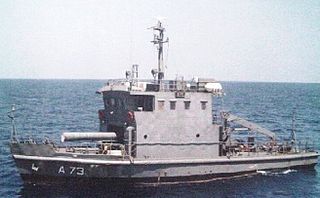
A sink is a bowl-shaped plumbing fixture for washing hands, dishwashing, and other purposes. Sinks have a tap (faucet) that supplies hot and cold water and may include a spray feature to be used for faster rinsing. They also include a drain to remove used water; this drain may itself include a strainer and/or shut-off device and an overflow-prevention device. Sinks may also have an integrated soap dispenser. Many sinks, especially in kitchens, are installed adjacent to or inside a counter.

A shipwreck is the wreckage of a ship that is located either beached on land or sunken to the bottom of a body of water. Shipwrecking may be intentional or unintentional. There were approximately three million shipwrecks worldwide as of January 1999, according to Angela Croome, a science writer and author who specialized in the history of underwater archaeology.

RMS Lusitania was a British ocean liner launched by the Cunard Line in 1906. She was the world's largest passenger ship until the completion of the Mauretania three months later and was awarded the Blue Riband appellation for the fastest Atlantic crossing in 1908. The Lusitania was sunk on her 202nd trans-Atlantic crossing, on 7 May 1915 by a German U-boat 11 miles (18 km) off the Old Head of Kinsale, Ireland, killing 1,197 passengers, crew and stowaways. The sinking occurred about two years before the United States declaration of war on Germany, but significantly increased American domestic public support for entering the war.

In maritime law, flotsam,jetsam,lagan, and derelict are specific kinds of shipwreck. The words have specific nautical meanings, with legal consequences in the law of admiralty and marine salvage. A shipwreck is defined as the remains of a ship that has been wrecked, whether it has sunk or is floating on the surface of the water.

SS Federico C. was a cruise ship that made headlines when its passengers were unloaded mid-way through their cruise and the vessel was put under arrest in Halifax Harbour. The ship then sank in international waters three months later. At the time of the sinking, It was owned by International Shipping Partners and insured for $20M while its scrap value was estimated at $5–6M.

This is a timeline for the Battle of the Atlantic (1939–1945) in World War II.

A salvage tug, known also historically as a wrecking tug, is a specialized type of tugboat that is used to rescue ships that are in distress or in danger of sinking, or to salvage ships that have already sunk or run aground.
A limpet mine is a type of naval mine attached to a target by magnets. It is so named because of its superficial similarity to the shape of the limpet, a type of sea snail that clings tightly to rocks or other hard surfaces.

The MS al-Salam Boccaccio 98 was an Egyptian Ro/Ro passenger ferry, operated by El Salam Maritime Transport, that sank on 3 February 2006 in the Red Sea en route from Duba, Saudi Arabia, to Safaga in southern Egypt.

Normac is a floating restaurant boat that was launched as a fire tug, named the James R. Elliot. She was built at the Jenks Shipbuilding Company in Port Huron, Michigan, in 1902.
Vector was a Philippine oil tanker that collided with the passenger ferry Doña Paz on December 20, 1987 in the Tablas Strait, Philippines, resulting in the deaths of an estimated 4,385 passengers and crew from the two ships. The incident is considered the deadliest peacetime maritime disaster in history.

Sinking ships for wreck diving sites is the practice of scuttling old ships to produce artificial reefs suitable for wreck diving, to benefit from commercial revenues from recreational diving of the shipwreck, or to produce a diver training site.
A number of different methods exist for disposing of a ship after it has reached the end of its effective or economic service life with an organisation.

ROKS Dokdo (LPH-6111) is the lead ship of the Dokdo-class amphibious assault ship of the Republic of Korea Navy, launched on 12 July 2005 at the shipyard of Hanjin Heavy Industries & Constructions Co. in Busan. ROKS Dokdo was the flagship of the Fifth Component Flotilla of the Korean Navy until the launch of ROKS Marado in 2018. Previously, this title was held by the 9,000-ton at-sea Underway Replenishment (UNREP) support vessel ROKS Cheonji.

Maersk Line is a Danish international container shipping company and the largest operating subsidiary of Maersk, a Danish business conglomerate. Founded in 1928, it is the world's second largest container shipping company by both fleet size and cargo capacity, offering regular services to 374 ports in 116 countries. In 2019, it employed 83,625 people where 18,398 of which are vessel crew and the other 65,227 are processing and operations personnel in offices and ports. Maersk Line operates over 708 vessels and has a total capacity of about 4.1 million TEU.

The Astravahini class of torpedo recovery vessels are a series of naval auxiliary watercraft built by Goa Shipyard Limited and P.S. & Company for the Indian Navy. They are intended to recover practice torpedoes and mines, fired and laid by ships, submarines and aircraft. The vessels can stow two full-sized torpedoes on deck and two on a recovery ramp.
Erg was a vessel built and owned by Halifax Steamship Ltd. in 1915. She was used to ferry workers across the harbour to vessels under repair during the Second World War. Erg was sunk in the Halifax Harbour three times and is currently located in the Bedford Basin.
MV Azburg was a Dominica-flagged general cargo ship that was sunk by Russian shelling while in port at Mariupol, Ukraine, on 5 April during the 2022 Russian invasion of Ukraine. It was built in The Netherlands in 1995 as Kroonborg.












